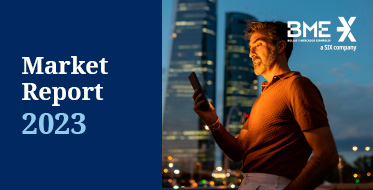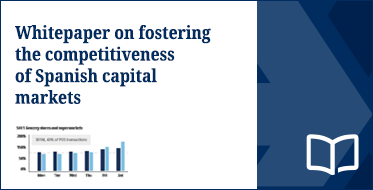The financing structure of Spanish large listed companies comes closer to the angloxaxon model

- Over the last 7 years the Spanish listed companies have reduced their debt and increased their market-based financing
- The equity of the IBEX 35’s non-financial institutions increased by 27%
- Financing via Fixed Income rose by 28% to 116 billion at the end of 2017
Between 2010 and 2017, the IBEX 35’s non-financial companies have engaged in an important deleveraging process as well as transforming their financing structure. This has brought about major changes, among them the increased weight of their equity and the replacement of bank credit with financing based on listed debt instruments.
"This is a process that brings the Spanish corporate financing model closer to that of countries such as the United States or the United Kingdom, which usually lead economic growth," states the report published today by the BME Research Department. This trend, also followed by other European countries, is very significant among those Spanish listed companies that are leading the internationalisation and growth drive which is gradually taking root in the processes of change and transformation of the Spanish production model. The diversification of the business financing sources is one of the main signs of this broad change. Worthy of note is the important role played in this trend by such platforms as MAB and MARF, BME’s growth markets for SMEs.
Across-the-board reduction of indebtedness
Over the last 7 years, the total indebtedness of the IBEX 35’s non-financial institutions has gone from representing 72.4% of the total amount of the balance sheet to 67.1%. In absolute terms, the financial liabilities of the homogeneous group of companies that have remained on the IBEX 35 decreased by 8%, from almost 230 billion euros to almost 210 billion euros.
Increase in equity financing
This reduction in the weight of external financial liabilities with respect to the total is compatible with the increasing weight of equity in the companies´ day-to-day running, which increased by 6.3% between 2010 and 2017. During this period, the equity (net assets) of the IBEX 35’s non-financial institutions grew by 27%, a figure that sets a trend for companies with privileged access to bank financing and Corporate Debt markets. The total equity of these companies in 2010 amounted to just over 142 billion euros (27.6% of its balance sheet) and in 2017 it rose to 180.9 billioneuros (32.9%, more than five percentage points over the previous record).
The strengthening of the balance sheet of the main listed companies is closely related to retained earnings, but also to the high volume of capital increases channelled through the stock exchange, which between 2014 and 2017 exceeded 120 billion euros (this figure includes significant contributions from capital increases made by banks).
Bank financing is 39% lower than 7 years ago
Bank financing and debts with credit institutions have a significant weight in (short term) current and non-current (long term) liabilities. And it is precisely this type of financing that has suffered the most important reduction. For the homogeneous set of IBEX 35 companies, between 2010 and 2017 bank financing was 39%, from 113.5 billion euros to 69.1 billion euros.
Financing via debt issues grows by almost 28%
The decrease in bank financing at non-financial institutions stands in contrast to a significant increase in financing via short and long-term debt issues. This type of funding, managed through the capital markets, increased by 28% during the period analysed, going from 90.8 billion euros in 2010 to 116.1 billion in 2017 for the IBEX 35. At the end of 2017, market-based financing surpassed that via banks by more than 47 billion euros (116.1 billion euros against 69 billion euros), while in 2010 the latter was 20 billion euros higher than the former (91 billion euros against 113 billion euros).
In terms of the balance sheet structure, market financing via Corporate Debt represented 39.6% of total financial liabilities in 2010 and stands at 55.3% in 2017.


